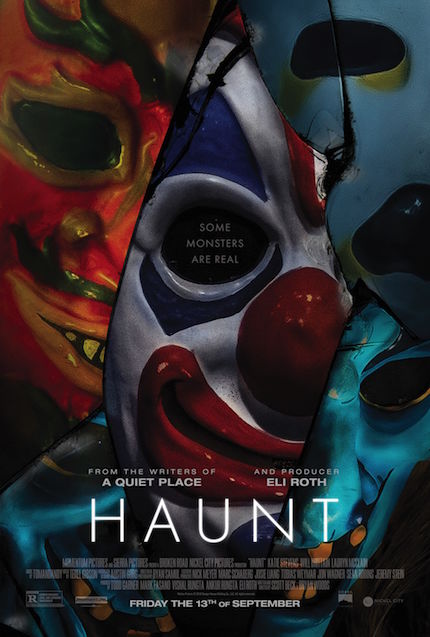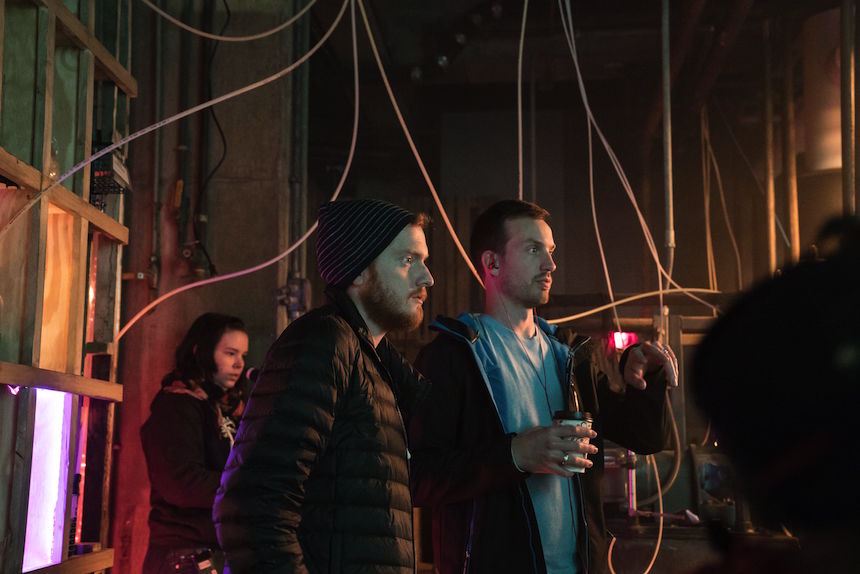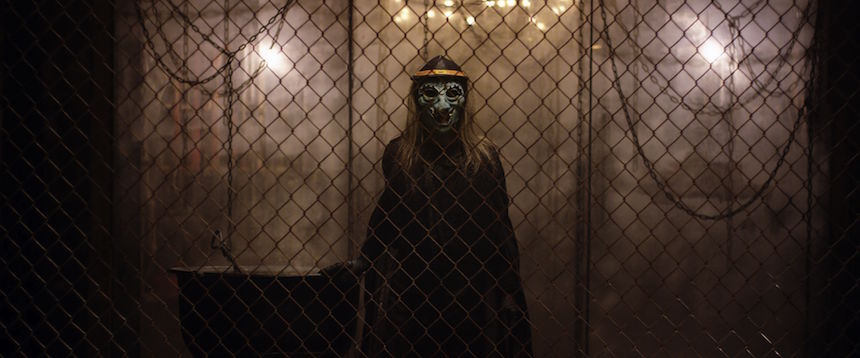HAUNT Interview: Bryan Woods And Scott Beck On Their Haunted Attraction Horror Effort

Haunted attractions have been a quintessential location for horror films. Just in 2019, It Chapter Two has a major scene involving James McAvoy’s Bill trying to save, at a funhouse, an innocent kid from Pennywise (Bill Skarsgård); and prior to their final encounter with the evil entity, the protagonists see themselves facing some classic haunted house scenarios.
Also, the new entry in Rob Zombie’s series about the murderous Firefly Family, 3 from Hell, is a reminder that this journey began when Zombie designed a haunted attraction for the Universal Studios’ Halloween Horror Nights back in 1999 (not to mention that the film version of this, House of 1000 Corpses, was very much influenced by, among others, Tobe Hooper’s The Funhouse).
Another brand-new addition to these haunted attraction horror films is Haunt, written and directed by Bryan Woods and Scott Beck, the young duo who also wrote the recent massive hit A Quiet Place. Produced by Eli Roth, Haunt follows Harper (Katie Stevens), a character with a harsh background and present: as a kid she had to witness the abusive behavior that her father (William Arnold) had towards her mother (Katy Arnold), and now as a college girl her own boyfriend (Samuel Hunt) is a violent alcoholic. Though Harper tries to act as if everything is cool, her friend Bailey (Lauryn Alisa McClain) wants her out of this conflictive relationship as soon as possible.
On Halloween, Harper joins Bailey and her other girlfriends (played by Shazi Raja and Schuyler Helford) for a fun night out, eventually connecting with another boy named Nathan (Will Brittain). Advised by Nathan’s acquaintance Evan (Andrew Caldwell), the whole group of youngsters decides to continue having a good Halloween time by visiting a haunted house attraction by the side of a road. Naturally, the creepy clown (Justin Marxen) who welcomes them will only be the first indication that the fun is over and that true horror awaits them in the form of a mysterious and brutal group of masked murderers.
Now that Haunt is in Theaters, On Demand and Digital, I share with you with my interview with writers-directors Bryan Woods and Scott Beck, who also talked about A Quiet Place, working with Eli Roth, and their favorite horror movies to watch on Halloween.
ScreenAnarchy: How have things changed for you after the massive success of A QUIET PLACE?
Bryan Woods: Well, it was such a fun experience to watch audiences embrace that film. A Quiet Place had really humble beginnings, at a period in our career where we were really frustrated because we were working on so many kind of studio-financed jobs, things that weren’t quite passion projects.
It was with this idea that we had at the back of our minds, that we just really believed in and just thought could be really special if a studio would ever give it a chance. To be able to watch audiences embrace it worldwide was so much fun and so gratifying. If anything, in the wake of its success it’s involving us to take big swings and really try to embrace original, bizarre, crazy ideas, and try to get those made.
How was the process to get HAUNT done and what was the origin of the idea?
Scott Beck: Bryan and I, we’ve known each other since we were 11 years old and we grew up in the same town in Iowa. Much of our childhood, every Halloween was going out to the haunted house attraction. The haunted houses that were built in Iowa actually were very down and dirty and pared-down, they would take over like abandoned factories and they would have volunteers that would just show up wanting to scare people to death.
We set into those experiences when writing the script, it very much was leaning into the idea of giving up all your safety to somebody else and then putting yourself into a vulnerable situation and then just leaning on the suspense of not knowing if what you were seeing was real or not, and playing off the imagination that you have when you walk in the dark corridor; try to build the haunted house of our childhood dreams.

I feel this is a personal story in that sense. So how do you choose which projects you also direct?
Woods: Haunt was kind of commissioned by this famous producer Todd Garner, he’s had his hands in a billion movies over the course of his long career. They just needed a script that they could believe in. It was a lot of fun to do.
Horror is a great genre for young filmmakers because you don’t need a big movie star, you don’t need Tom Cruise [laughs] to be the star of your film; people just really are into the genre so it’s a great proving ground. Many of our favorite filmmakers, whether it's Francis Ford Coppola or Peter Bogdanovich, even Steven Spielberg, they all cut their teeth on low-budget horror films. Spielberg started with this terrific movie called Duel, before he got to make Jaws. And so, we always saw Haunt as a bit of a proving ground to kick off our career with.
As a genre effort, HAUNT plays with a lot of typical elements: the haunted house attraction and even the part of the escape room. In that sense, for you, what were the challenges when trying to make something fresh and to keep audiences interested?
Beck: Yeah, absolutely, I mean, that’s one of the things that I think in the horror genre in general, we are always trying to challenge ourselves; like, how do you keep it interesting? How do you keep it fresh? For us, certainly on A Quiet Place, that was leaning into the idea of being essentially a silent horror movie, utilizing sound design to create this incredibly scary soundscape and landscape.
With Haunt, we’ve seen certain haunted house movies before, I think our window into that was in following Harper, that is the lead in the film, and her traumatic baggage. It’s very much trying to figure out what are the different set pieces throughout the movie; we talked about Haunt as being one set piece after another and leaning into the expectations of what somebody might expect when they watch a scene; for instance the sequence where they have to guess the body part and you sink your hand through this dark hole and you’re not sure what’s going to be on the other side, you know something that might happen but you hold that out a little longer, have the audience’s expectation and hopefully in the realm of Hitchcock... he played the audience like a piano.

Now that you mentioned some of the protagonist’s background, where did that came from?
Woods: Yeah, anytime we write a horror story, we always ask ourselves, what is the theme? What is the thematic backdrop that we are exploring here? When we thought about doing a haunted house movie on Halloween, we had to ask ourselves, what is the Halloween theme? What does that mean to people?
As we started to talk about it, we realized Halloween is all about putting on a costume or a mask and pretending to be somebody that you are not. So we thought that there was a really interesting kind of metaphorical undercurrent there, when we came up with the idea of this young woman who’s wrestling with her metaphorical haunted house.
She’s putting on a front, a mask of sorts; to her friends and family she’s saying like "everything is fine, I’m OK, there’s nothing wrong with me, everything is great." We thought that would be a really interesting backdrop to kind of explore and push her through a real haunted house and watch her change and grow and eventually unmask herself, while the villains in our movie are literally unmasking themselves.
The look of the antagonists, how fun was to create the masks? And also when they take them off, the look of their faces, it all feels iconic…
Beck: Yeah, well, thank you for saying that. That was one of the more fun things of deciding, certainly leaning into the Halloween masks. We enlisted our team, led by our production designer Austin Gorg, with the challenge of trying to create a Halloween mask that felt like something you might see like in the 1940s or the 1950s, with monsters, a witch or a clown or a ghost, and create something that felt terrifying yet slightly innocent.
We always knew it was going to lead up to the big reveal of when these villains are actually going to take off their masks. And then in terms of deciding what’s under there, certainly we were very grateful to have two incredible makeup designers: Hugo Villaseñor and Chris Bridges, who were able to definitely create something that we felt would be very terrifying and hopefully unexpected for audiences once the masks finally came off. It definitely was just leaning into our love of Halloween as a season.
The villains remain mysterious in the end. We might be asking, who are these people? Did you have like a background that you know but didn’t really want to share with the audience? How this decision was made?
Woods: Yeah, I mean our philosophy is always less is more, we love when the audience can participate in the story and come up with their own theories. We did that in A Quiet Place, where we did not give hardly any context to the alien or invasion or what happened before the movie started, because we love just the suggestion on the periphery of what might have happened.
We did the same thing on Haunt. We talked a lot about it with our producer Eli Roth, he felt very strongly that we all needed to know the backstory even if we didn’t communicate that to the audience, he felt that the audience needed to know that we know, so that we kind of suggest into it, which we absolute love doing. We have always watched out backstories of villains, perhaps that could be part of another Haunt movie; but we also love the mystery, we love embracing the mystery of it.

How was working with Eli Roth? I felt that maybe when the male protagonist [Nathan] uses a baseball bat was a nod to INGLOURIOUS BASTERDS.
Beck: [Laughs] Eli was fantastic. And I love that you mentioned that connection with Inglourious Basterds. Eli had come on board actually after we already had the early version of the script prepared. He always wanted to have his hands on a haunted house movie and being searching for one for a long time. He read the script and he felt like it was the perfect time to come on board as producer.
We absolutely adored working with him because as teenagers we would seek out his DVD commentaries and treat them as a film school of sort; he would just unload his knowledge of the genre and more importantly, maybe to us, his experience on the successes and failures as a filmmaker, that were incredibly educational.
So being able to have that with him directly, definitely was a guiding force throughout the entire process of the film, and leaning on his knowledge of the horror genre just was an extra that we were able to put the film underneath from a script stage to actually shooting it to post-production. He was a wonderful ally to have throughout the film.
You have a direct reference to NIGHT OF THE LIVING DEAD, we see the characters watching it on TV. In that sense, can you name some of your top horror films for Halloween?
Woods: We love Alien, which we think is a great horror film even though it clearly has some science fiction elements. You have to watch Halloween during Halloween, it just goes without saying. Even some of the sequels are really fun.
The Fly, Invasion of the Body Snatchers we love; like Night of the Living Dead, Invasion of the Body Snatchers is a brilliant film because it’s early horror, we are talking about the 1950s and 1960s, it’s extremely entertaining, thrilling and suspenseful but it also has kind of a social conscious: it seems to be saying something about the time that the movie was made in, and even as it’s being remade through the years, the story continually comment on what we are going through as people in our country and our planet. Those are some of our favorites.







